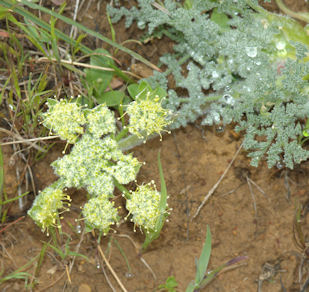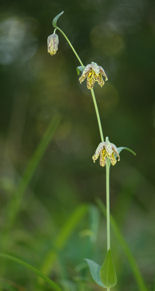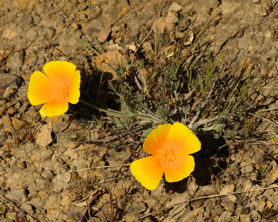Early SpringLace-leaf Sanicle
 These are common in Sky Oaks and around Lake Lagunitas mid to late March and forward into April. The three Sanicles in this small area are differentiated primarily by the color of their flowers. The flowers of this plant Sanicula laciniata are yellow. The flowers of Sanicula crassicaulis below are greenish-yellow, while Sanicula bipinnatifida which will show up later has purple flowers. We saw the purple sanicle on Azalea Hill.
These are common in Sky Oaks and around Lake Lagunitas mid to late March and forward into April. The three Sanicles in this small area are differentiated primarily by the color of their flowers. The flowers of this plant Sanicula laciniata are yellow. The flowers of Sanicula crassicaulis below are greenish-yellow, while Sanicula bipinnatifida which will show up later has purple flowers. We saw the purple sanicle on Azalea Hill.
Family: Apiaceae
Scientific Name: Sanicula laciniata
Calflora
Pacific Sanicle
 You will find this Sanicle is common around Sky Oaks. We found this one on the north side of Lake Lagunitas along the perimeter road between the restrooms and the ranger's cottage, on the uphill side. We saw it in 2010 at the very end of March.
You will find this Sanicle is common around Sky Oaks. We found this one on the north side of Lake Lagunitas along the perimeter road between the restrooms and the ranger's cottage, on the uphill side. We saw it in 2010 at the very end of March.
Family: Apiaceae
Scientific Name: Sanicula crassicaulis
 This plant is pretty common early in Spring. We found a number of Hairy Hog Fennel on the straight section of the perimeter road on the uphill side between the third bridge and the restrooms on the southeast side.
This plant is pretty common early in Spring. We found a number of Hairy Hog Fennel on the straight section of the perimeter road on the uphill side between the third bridge and the restrooms on the southeast side.
Family: Apiaceae
Scientific Name: Lomatium dasycarpum ssp. dasycarpum
Calflora
Viola-Western Heart's Ease
 If you are just hiking around Lagunitas you could easily miss this sweet violet. We have regularly found a few plants about sixty feet before the first Lagunitas bridge on the uphill side. Around the First of April 2008 we noted a number blooming on the uphill side past the second bridge.
If you are just hiking around Lagunitas you could easily miss this sweet violet. We have regularly found a few plants about sixty feet before the first Lagunitas bridge on the uphill side. Around the First of April 2008 we noted a number blooming on the uphill side past the second bridge.
Family: Violaceae
Scientific Name: Viola ocellata
Calflora
Checker Lily

 Mission Bells,
Fritillary or Fritillaria (I usually called them the latter.) We would always see a few a season until 2008 when either we were paying more attention or there were just many more. The Kent trail along Alpine Lake towards Bon Tempe was in areas rife, yes rife, with Mission Bells sometimes in the same area as carpets of Scoliopus leaves.
Mission Bells,
Fritillary or Fritillaria (I usually called them the latter.) We would always see a few a season until 2008 when either we were paying more attention or there were just many more. The Kent trail along Alpine Lake towards Bon Tempe was in areas rife, yes rife, with Mission Bells sometimes in the same area as carpets of Scoliopus leaves.
Family: Liliaceae
Scientific Name: Fritillaria affinis var. affinis
CalfloraZigadenus-Star Lily


When it's Star Lily time you can find it all over the Sky Oaks area. We found the plant to the left just before the third bridge around Lake Lagunitas at the end of March 2008. The one on the right we found on the No Name Trail about the same time in 2009. Tall pretty plant.
Family: Liliaceae
Scientific Name: Zigadenus fremontii var. fremontii
CalfloraIris
 I know, I know, there aren't many Iris in the Sky Oaks area. I'm going on height and have noted that we don't have 2 dm here so I'm sure it is Ground Iris. Look for it around the end of March.
I know, I know, there aren't many Iris in the Sky Oaks area. I'm going on height and have noted that we don't have 2 dm here so I'm sure it is Ground Iris. Look for it around the end of March.
Family: Iridaceae
Scientific Name: Iris microsiphon
CalforaSky Lupine
 This pretty field of lupine was about a quarter mile (or less) beyond the Sky Oaks kiosk towards the lakes at the first bend in the road on the downhill side. If it's the end of March you probably won't miss them.
This pretty field of lupine was about a quarter mile (or less) beyond the Sky Oaks kiosk towards the lakes at the first bend in the road on the downhill side. If it's the end of March you probably won't miss them.
Family: Fabaceae
Scientific Name: Lupinus nanus
Calflora
Striated Coralroot Orchid
 We have come to believe that the last day of March is when Spring really starts showing her stuff. This orchid is easy to miss as you walk from the Lake Lagunitas parking lot along the trail to Bon Tempe. We were a bit anxious in 2008 because this area above the trail where I first saw it in 1994 suffered a slide. We were lucky, however, and found the plant proudly emerged from the hillside chaos.
We have come to believe that the last day of March is when Spring really starts showing her stuff. This orchid is easy to miss as you walk from the Lake Lagunitas parking lot along the trail to Bon Tempe. We were a bit anxious in 2008 because this area above the trail where I first saw it in 1994 suffered a slide. We were lucky, however, and found the plant proudly emerged from the hillside chaos.
Family: Orchidaceae
Scientific Name: Corallorhiza striata var. striata
Calflora
Tamalpais Manzanita

 I've been taking the lower Stocking trail up to Rocky Ridge for thirty years so we were surprized to see the warning sign as we got to the top just off the fire road. Down the hill from the sign (a few dozen yards) we had hiked through a large stand of Tamalpais Manzanita and Musk Brush (see below) blooming in full glory. It was the last day of March.
I've been taking the lower Stocking trail up to Rocky Ridge for thirty years so we were surprized to see the warning sign as we got to the top just off the fire road. Down the hill from the sign (a few dozen yards) we had hiked through a large stand of Tamalpais Manzanita and Musk Brush (see below) blooming in full glory. It was the last day of March.
Family: Ericaceae
Scientific Name: Arctostaphylos hookeri ssp. montana
Calflora
Musk Brush

 This is a very pretty Ceanothus, particularly with the holly-shaped leaves. The plant to the left was cheek to jowl with the manzanita described above in the chaparral below the Rocky Ridge FR where the old Stocking Trail crosses west. The plant to the right was found the next year in 2009 as we stumbled along the No Name Trail above the Berry Trail. What surprized us on the No Name Trail was, like on the Stocking Trail, the Musk Brush was married to the Tamalpais Manzanita. Well, is someone pimping on anothers' allelopathy or do they just like the same neighborhoods. Not sure.
This is a very pretty Ceanothus, particularly with the holly-shaped leaves. The plant to the left was cheek to jowl with the manzanita described above in the chaparral below the Rocky Ridge FR where the old Stocking Trail crosses west. The plant to the right was found the next year in 2009 as we stumbled along the No Name Trail above the Berry Trail. What surprized us on the No Name Trail was, like on the Stocking Trail, the Musk Brush was married to the Tamalpais Manzanita. Well, is someone pimping on anothers' allelopathy or do they just like the same neighborhoods. Not sure.
Family: Rhamnaceae
Scientific Name: Ceanothus jepsonii var. jepsonii
Calflora
Buck-Brush
 While not as pretty as its' musky cousin this ceanothus is one of the first to bloom in a series of spring flowering shrubs you can find in the area around Lake Lagunitas that includes Pacific Ninebark and Cream Bush. This plant was just west of the Rocky Ridge FR a few dozen yards down the Stocking trail.
While not as pretty as its' musky cousin this ceanothus is one of the first to bloom in a series of spring flowering shrubs you can find in the area around Lake Lagunitas that includes Pacific Ninebark and Cream Bush. This plant was just west of the Rocky Ridge FR a few dozen yards down the Stocking trail.
Family: Rhamnaceae
Scientific Name: Ceanothus cuneatus var. cuneatus
Calflora
Califonia Huckleberry
 A few years ago MMWD realigned a stretch of the Kent Trail between Hidden lake and Alpine. Jeanne and I were hiking down the Kent Trail and came across the staff working to build the new path. They were gracious and escorted us through their work zone. Now, if you want to see Huckleberry, that part of the Kent Trail is one place to go. Indeed we found the plant in the left photo on the Kent Trail at the very end of March.
A few years ago MMWD realigned a stretch of the Kent Trail between Hidden lake and Alpine. Jeanne and I were hiking down the Kent Trail and came across the staff working to build the new path. They were gracious and escorted us through their work zone. Now, if you want to see Huckleberry, that part of the Kent Trail is one place to go. Indeed we found the plant in the left photo on the Kent Trail at the very end of March.
Huckleberry is, of course, all over The Sky Oaks area and we also found it blooming in mid-May (right Photo) around Lake Lagunitus past the second bridge.
The three photos below show the Huckleberry berries maturing from green to red. We found all these stages in mid-July around Lake Lagunitus.



Family: Ericaceae
Scientific Name: Vaccinium ovatum
Calflora
Spotted Coralroot Orchid
 We saw the Striated Coralroot at the beginning of the loop hike and now, half-way through, we come across the Spotted one. This orchid was found along the part of the Kent Trail that hugs the Alpine Lake shore up to Bon Tempe Dam. This stretch, at the end of March in 2008, was lush with Adder's Tongue leaves, Mission Bells and Indian warrior. I initially walked right by it until Jeanne called out--What about this!?
We saw the Striated Coralroot at the beginning of the loop hike and now, half-way through, we come across the Spotted one. This orchid was found along the part of the Kent Trail that hugs the Alpine Lake shore up to Bon Tempe Dam. This stretch, at the end of March in 2008, was lush with Adder's Tongue leaves, Mission Bells and Indian warrior. I initially walked right by it until Jeanne called out--What about this!?
 I always believed that Corallorhiza bloomed in late March and early April. Well, that assumption changed when we found this maculata (right photo) growing out of a tree root on the lake side past the second Lagunitas bridge in mid-May of 2009.
I always believed that Corallorhiza bloomed in late March and early April. Well, that assumption changed when we found this maculata (right photo) growing out of a tree root on the lake side past the second Lagunitas bridge in mid-May of 2009.
I must admit, however, I'm really getting skittish about photographing wildflowers at the base of trees. A month after finding this maculata, the lake-side trunk of the tree fell. This wouldn't have given me pause except that months before, a few weeks after photographing Scoliopus at the base of a tree just past the first bridge, the tree fell, on the bridge!
Family: Orchidaceae
Scientific Name: Corallorhiza maculata var. muculata
Calflora
Calypso Orchid
 Every year that I hiked the Alpine portion of the Kent Trail around the end of March I would find a solitary Calypso Orchid just off the trail, always in the same spot. In recent years there have been slides and earth movement on this trail section and in 2008 I didn't even recognize the area where I usually found the plant. That didn't mean it wasn't there, indeed, we found five or six orchids in the general area where I used to see just one.
Every year that I hiked the Alpine portion of the Kent Trail around the end of March I would find a solitary Calypso Orchid just off the trail, always in the same spot. In recent years there have been slides and earth movement on this trail section and in 2008 I didn't even recognize the area where I usually found the plant. That didn't mean it wasn't there, indeed, we found five or six orchids in the general area where I used to see just one.
Family: Orchidaceae
Scientific Name: Calypso bulbosa var. occidentalis
Calflora
Blue-eyed Grass
 It's Blue-eyed Grass. There you go.
It's Blue-eyed Grass. There you go.
Oh, and it's not a grass.
Family: Iridaceae
Scientific Name: Sisyrinchium bellum
Calflora
Yellow Monkeyflower
 Love this flower. I'll shoot a better photo. These plants were in a open rocky area on the Kent trail a long quarter mile from the Bon Tempe Dam.
Love this flower. I'll shoot a better photo. These plants were in a open rocky area on the Kent trail a long quarter mile from the Bon Tempe Dam.
Family: Scrophulariaceae (Phrymaceae)
There are major taxonomic changes to the Scrophulariaceae that have been emerging in scientific papers, books and guides in recent years. In part they include moving some genera to two other families: Phyrmaceae that now includes Mimulus and Orobanchaceae that now among other changes includes Castilleja (Paintbrush.)
Scientific Name: Mimulus guttatus
Calfora
California Poppy
 It's easy to forget how variable and attractive this plant is and how it seems to be everywhere for a long time.
It's easy to forget how variable and attractive this plant is and how it seems to be everywhere for a long time.
Family: Papaveraceae
Scientific Name: Eschscholzia california
Calflora
Fat Solomon
 This plant surprized us; we had never seen it around Lake Lagunitas. We found this cutie on the west side just past the fork where the perimeter road heads down towards the lake. It was on the lake side during late March persisting into April .
This plant surprized us; we had never seen it around Lake Lagunitas. We found this cutie on the west side just past the fork where the perimeter road heads down towards the lake. It was on the lake side during late March persisting into April .

Family: Liliaceae
Scientific Name: Maianthemum racemosum ssp. amplexicaule
Calflora
SpringHome
Comments and Corrections
 These are common in Sky Oaks and around Lake Lagunitas mid to late March and forward into April. The three Sanicles in this small area are differentiated primarily by the color of their flowers. The flowers of this plant Sanicula laciniata are yellow. The flowers of Sanicula crassicaulis below are greenish-yellow, while Sanicula bipinnatifida which will show up later has purple flowers. We saw the purple sanicle on Azalea Hill.
These are common in Sky Oaks and around Lake Lagunitas mid to late March and forward into April. The three Sanicles in this small area are differentiated primarily by the color of their flowers. The flowers of this plant Sanicula laciniata are yellow. The flowers of Sanicula crassicaulis below are greenish-yellow, while Sanicula bipinnatifida which will show up later has purple flowers. We saw the purple sanicle on Azalea Hill.




























